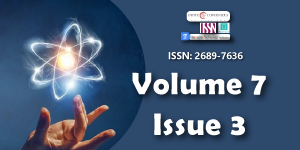Thermodynamic Analysis of Ammonia Synthesis
Main Article Content
Abstract
The paper researches the effect of temperature on ammonia synthesis. The ammonia synthesis reaction N2(g)+3H2(g)=2NH3(g) is exothermic with a negative entropy change. ∆G < 0 condition is fulfilled at lower temperatures up to 464K (Le Chatelierov principle). It is a constant equilibrium of the ammonia synthesis reaction Kp'>>1 at lower temperatures, which means that the NH3(g) synthesis reaction is shifted in the direction of NH3(g) formation (higher production of ammonia). The downside of lowering the temperature is that more ammonia is obtained, but the reaction rate slows down. Above 464K, the free enthalpy of the NH3(g) synthesis reaction is greater than zero, so the reaction enters thermodynamically unfavorable conditions. By increasing the reaction temperature, the ammonia yield NH3(g) decreases in the equilibrium mixture. At 400K, it is 0.5127kmol/kmol (51.27%) and at 700K, the synthesis process NH3(g) is practically complete.
Downloads
Article Details
Copyright (c) 2024 Đurić S.

This work is licensed under a Creative Commons Attribution 4.0 International License.
Đurić NS, Đaković DD. Improving the energy and environmental efficiency of thermal power plants by lowering the dew point temperature of flue gases. Termotehnika. 2010;XXXVI(2-3):233-245. (In Serbian: Unapređenje energetske i ekološke efikasnosti termoelektrana snižavanjem temperature tačke rose dimnih gasova).
Cui P, Zhou Y, Song T, Xu Z, Zhang J, Liu Y, et al. Thermodynamic and economic analysis of an ammonia synthesis process integrating liquified natural gas cold energy with carbon capture and storage. ACS Sustainable Chem Eng. 2023;11(7):1-6. Available from: https://doi.org/10.1021/acssuschemeng.2c06841
Kim H, Oh S, Mun H, Kim D, Lee I, Moon IL. Advanced design of ammonia production processes from LNG: Efficient and economical cold energy utilization methods. Ind Eng Chem Res. 2023;62(19):7566-7579. Available from: https://doi.org/10.1021/acs.iecr.3c00058
Christiansen LJ. Thermodynamic properties in ammonia synthesis. Berlin: Springer-Verlag; 1995. Available from: https://link.springer.com/chapter/10.1007/978-3-642-79197-0_1
Schlögl R. Ammonia synthesis. Berlin: Fritz-Haber-Institute of the MPG; 14195 Berlin. Available from: https://pure.mpg.de/rest/items/item_736938_6/component/file_932945/content
Shamiri A, Aliabadi N. Modeling and performance improvement of an industrial ammonia synthesis reactor. Chem Eng J Adv. 2021;8:100177. Available from: https://doi.org/10.1016/j.ceja.2021.100177
Karavaev MM, Zasorin AP, Klešeev NF. Katalitičeskoe okislenie ammiaka. Moscow: Himija; 1983.
Navid, Luqmanulhakim B, Matthew W. Recent advances and intensifications in Haber-Bosch ammonia synthesis process. Chem Eng Process Process Intensif. 2024;204:109962. Available from: https://doi.org/10.1016/j.cep.2024.109962
Wei Q, Lucero JM, Crawford JM, Way JD, Wolden CA, Carreon MA. Ammonia separation from N2 and H2 over LTA zeolitic imidazolate framework membranes. J Membr Sci. 2021;623:119078. Available from: https://doi.org/10.1016/j.memsci.2021.119078
DeVoe H. Thermodynamics and Chemistry [Internet]. 2nd ed. Version 10. College Park, Maryland: University of Maryland; 2020. Available from: https://www2.chem.umd.edu/thermobook/v10-screen.pdf
Kuo J. Chemistry, Thermodynamics, and Reaction Kinetics for Environmental Engineers. 1st ed. 2025. Available from: https://doi.org/10.1201/9781003502661
Johnson DA. Some thermodynamic aspects of inorganic chemistry. Cambridge: Cambridge University Press; 1982. Available from: https://www.cambridge.org/in/universitypress/subjects/chemistry/chemistry-general-interest/some-thermodynamic-aspects-inorganic-chemistry-2nd-edition?format=PB&isbn=9780521285216
Barin I, Knacke O. Thermochemical Properties of Inorganic Substances. Berlin-Heidelberg-New York: Springer-Verlag; 1973. Available from: https://www.springer.com/series/2212?srsltid=AfmBOoou1vz4BcMaYwUvCqMsuMgtlIqCgzKd-CbdoamUr88Tbmf2jIWw

